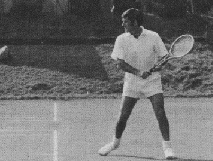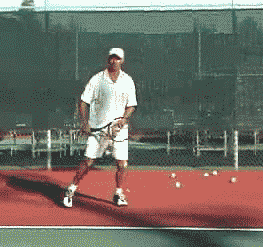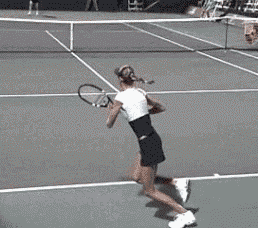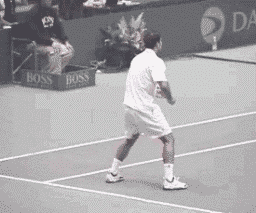|
TennisOne Lessons


Adapt and Win: The Slice
by Tom March
|

Once the prototype backhand, modern players can still learn from the Rosewell model. |
At the top levels of our sport, everyone recognizes the game has gotten bigger. Bigger, stronger athletes hitting bigger serves and groundstrokes. On the women's side of the tour, Mary Carillo, always adept at fashioning a phrase, calls it “Big Babe Tennis.” On the men's side, she calls it “First Strike” tennis. How does it work? Hit a big first serve which sets up a weak reply. Then run around your backhand (a la Bollettieri), and crush a winning forehand.
First, let me say I'm not criticizing or finding fault with these tactics. Look around at the Williams sisters or what Andy Roddick has been doing this year, you can see this style of play obviously works. On the other hand, I've been watching players at the professional level and top junior levels for 15 years, and I do think there is something missing in the arsenal of many aspiring players: the slice. The irony is the bigger and more aggressive the game, the more the slice shot becomes important.
No, I'm not calling for a return to a nostalgic past, where Ken Rosewall's slice backhand was the model for every player. Although players can still learn from the Rosewell model. In fact, the slice shot has never gone away. It's just hidden beneath the dust kicked up by the Monster Game. It wasn't that long ago that John McEnroe's (Mac the Knife) slice helped make him the number one player in the world.
Roll forward a bit, and you can see Matts Wilander beating Ivan Lendl in the US Open final utilizing his slice backhand. Now move into the current era and see how Andre Agassi has improved his defensive skills utilizing the slice. Even the current reigning champion of First Strike tennis, Andy Roddick, utilizes the slice off both the backhand and forehand sides.
|

For every degree swung downwards, the racquet face must be one degree open. |
How to Hit the Slice
Let's break down the slice into its two basic forms. First, a more blocking or flatter motion and second, a descending or downward angled motion.
On harder hit balls, high deep shots, short low shots, balls taken on the rise or whenever one is in a defensive position, a short, flatter, almost blocking motion is best. Usually a continental or service grip would be used on the backhand side and a grip in between an eastern forehand and a continental grip would be used on the forehand side.
When attempting this shot, one should literally have the feeling of “volleying the ball back.” The motion is a slightly larger version of a blocking style volley used against a hard hit passing shot. This type of slice can be used in any situation and is more versatile and effective than the riskier and harder to hit downward or chopping slice motion.
On a slower ball, you have the option to hit a more downward style of stroke. But, for every one degree swung downwards on the stroke, the racquet face must be one-degree open. In other words, the more downward the more the racquet face must be opened. For this stroke, move towards the continental grip on the forehand side and a grip between a continental and eastern forehand on the backhand side. Don't be afraid to experiment, vary the grips slightly and use the lower arm rotation or wrist position to adjust to a grip that feels comfortable.
As mentioned before, the downward swinging slice can be more difficult to play than the flatter, blocking style slice, but it can be more fun to play and it can be an extremely effective way to disguise a great drop shot. After hitting two or three downward angled swings where the ball lands deeper in the court, just open the racquet face a lot more, swing downward and viola, a drop shot that will catch your opponent off guard.
Now let's look at the use of the slices as a defensive and yes, as an offensive weapon as well.
Defensive Slice
Simply put, the more aggressive and offensive the game, the more you need defense. The slice shot is one of the keys to your defense. Why? The slice can be executed more quickly and simply, and with less effort, than hitting a topspin driving shot.
While you can hit a slice with a long, flowing motion using the appropriate lower and upper torso rotation, the slice can also be hit similar to a volley (however, the ball bounces off the ground before the stroke), with minimum body rotation. Simply get the racquet face in front of the flight path of the ball and utilize the energy of your opponent's shot to generate your own shot.
The simplicity and speed of execution, then, makes the slice the best antidote to the modern game's big serve. Look at how masterfully Roger Federer utilized his slice return to neutralize Roddick and Philippoussis in this year's Wimbledon semifinals and finals.
When someone is serving at you 140 miles an hour, you simply don't have time to hit topspin returns. Even at the club level, where some first serves might seem like they're coming at you at 140 mph, you can dramatically increase your return percentages by adopting a simple blocking slice return. Use a smaller unit turn, and take-back and simply get that racquet face into the path of the serve and make contact as you move forward. Again, think “volley after the bounce” and you'll have the right mind-set to execute an effective slice block.
|

Daniela Hantuchova, on the defensive, stretches wide using a one-handed slice yet still has time to recove . |
How else is the slice shot used defensively? Basically, whenever there isn't time or you aren't set-up to hit your topspin drives. This typically happens if your opponent drills a ball at your feet while you're standing on the baseline or if you're pulled out wide. When you're forced to hit a slice return after being pulled out wide, the slower pace of the slice actually works to your advantage. A slower return slice gives you additional time to recover to the middle of the court.
Who does this well? Actually, most of the top players. I've already mentioned Andre Agassi and Roger Federer, but you'll also see the defensive slice from the Williams sisters, allowing them to stay in points they would otherwise lose.
Finally, the slice allows players, especially club players, to handle groundstrokes that bounce up or past shoulder height. Professional players with Western or semi-Western grips and superior footwork can typically return these high-bouncers utilizing their topspin shots. But club players, who more often utilize an Eastern or Continental grip, will usually have difficulty executing a topspin shot off a high-bouncer. The safer, easier return will be a slice shot for most players.
Offensive Slice
Given the dominance of the topspin drive in today's game, even to speak of an offensive slice seems like an oxymoron. But it's not. In fact, many of the defensive elements of the slice are precisely what make it an offensive weapon. But before we move into the details, let me also emphasize that the slice shot doesn't have to be hit with a banana like swing: an exaggerated high-to-high motion. Certainly the slice return off a big serve can be a flat, blocking motion than can pressure any server coming to the net.
|
Click photo to watch Pat Rafter use an aggressive slice return to set up a volley winner. |
In a groundstroke rally, a slice can be hit with a much flatter swing path, and Ken Rosewall demonstrated how effective this could be.
On a high sitter close to the net, use more of a downward angled stroke. On a deep high ball, use more of a flatter blocking motion. A downward angle shot from the baseline would have a greater tendency to go into the net.
Let's look at some of the particular offensive advantages of the slice.
Slower Ball. I've already described how the slower pace of the slice return allows a player to recover to the center of the court if pulled out wide. But this slower pace also can be used offensively, as it allows a player to get deeper into the net off an approach shot. Patrick Rafter won two US Open titles using this offensive weapon, and it played an important role in Pete Sampras' seven Wimbledon championships.
Movement Through the Shot. A little recognized attribute of hitting the slice shot is that a player can actually run through this shot on his/her way to the net. Using the cross-over or karaoke step, a player flows through the shot, eliminating the time required for the split-step. If you're looking for a model for this flowing footwork off the slice, think Stefan Edberg, but Patrick Rafter, Pete Sampras and many other great volleyers used it also.
Ball Stays Lower. Everyone knows that a slice shot stays lower than a topspin shot, but they are often mistaken about the reason. Typically, players think that backspin is the reason. Actually, the spin of the ball is irrelevant to the height of the bounce. It's the trajectory of the ball that determines the height of the bounce. It just so happens that slice shots are hit with a lower trajectory (i.e., flatter) over the net than topspin balls.
|

Sampras hit a slice backhand using the carioca step, this combination allows him to get to the net quicker. |
Players really don't need to dwell too much about the physics, as long as they grasp the advantages of keeping the ball low. This is particularly an advantage when coming to the net, as your low, slice approach shots will make your opponent hit up, setting up much easier volleying situations.
Hitting Short. At this year's French Open, commentators proclaimed “the drop-shot is back.” Again, I don't know if it ever disappeared, but I think players, particularly the Europeans who play more regularly on clay, are using the drop shot more effectively.
Once you've learned to hit the slice shot, which requires an open-face racquet, it's much easier to master the drop-shot. In general, hitting short is an under-appreciated offensive tactic in tennis. McEnroe was a master of this, drawing his opponent in with a sharp cross-court slice then setting up an easy volley to the open court.
Change of Pace. One the simplest and most effective tennis strategies is to give your opponent what he or she doesn't like. If a player has only practiced and played against topspin players, chances are this player isn't going to like fielding slow, low, slice shots. With a slice shot in your arsenal, you can break up your opponent's rhythm by a change of pace slice shot. This is particularly useful if you feel your opponent's topspin shots are as good or better than yours.
Wrap-up
Again, I want to make clear that I'm not yearning for the return of a golden age of tennis. I love to hit as big as the next guy, and I certainly teach my students to be as aggressive as their games allows, encouraging them to run around their backhands and punish their opponents with driving topspin shots. At the same time, I encourage them (and you) to learn how to utilize the slice defensively and offensively because an effective slice could very well be the difference between winning and losing.
Your comments are welcome. Let us know what you think about Tom March's article by emailing us here at TennisONE.

 Tom March has been coaching world ranked players on both the ATP and WTA circuits for over 16 years in Europe. Tom has worked with over 60 world ranked tennis professionals as a personal coach (some of whom were in the top 100). Tom has coached professional players at all of the Grand Slams (Wimbledon, French Open, US Open, and Australian Open), ATP and WTA events, Davis Cup and Federation Cup events. Tom developed and coached three national junior champions and has worked for the German Tennis Association as a High Performance Coach. Tom March has been coaching world ranked players on both the ATP and WTA circuits for over 16 years in Europe. Tom has worked with over 60 world ranked tennis professionals as a personal coach (some of whom were in the top 100). Tom has coached professional players at all of the Grand Slams (Wimbledon, French Open, US Open, and Australian Open), ATP and WTA events, Davis Cup and Federation Cup events. Tom developed and coached three national junior champions and has worked for the German Tennis Association as a High Performance Coach.
Tom is presently the Head Tennis Professional at the Almaden Valley Athletic Club in San Jose. Tom is also a member of the Men's 5.5 team that will represent Northern California at the Nationals in 2003.
|
|





 Tom March has been coaching world ranked players on both the ATP and WTA circuits for over 16 years in Europe. Tom has worked with over 60 world ranked tennis professionals as a personal coach (some of whom were in the top 100). Tom has coached professional players at all of the Grand Slams (Wimbledon, French Open, US Open, and Australian Open), ATP and WTA events, Davis Cup and Federation Cup events. Tom developed and coached three national junior champions and has worked for the German Tennis Association as a High Performance Coach.
Tom March has been coaching world ranked players on both the ATP and WTA circuits for over 16 years in Europe. Tom has worked with over 60 world ranked tennis professionals as a personal coach (some of whom were in the top 100). Tom has coached professional players at all of the Grand Slams (Wimbledon, French Open, US Open, and Australian Open), ATP and WTA events, Davis Cup and Federation Cup events. Tom developed and coached three national junior champions and has worked for the German Tennis Association as a High Performance Coach.